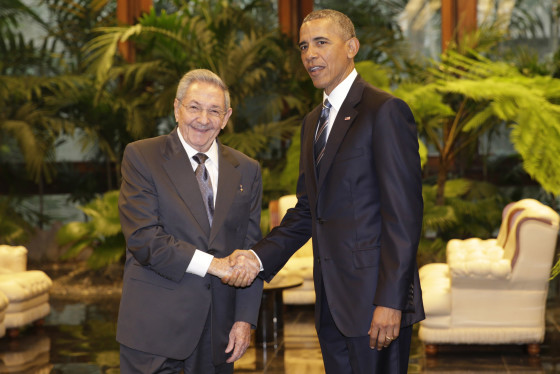
Cuba comes into focus, and in color
Seeing the Cubans waiting for glimpses of the Obamas, you can see the informality of the country and its apparent love of color.
Whether you think President Barack Obama’s visit to Cuba is a graceful piece of foreign policy or ill-advised pandering to old commies, the images are certainly striking. Cuba is like a grainy black-and-white 8 mm movie gradually resolving into Red One HD color.
You can clearly see Cuba’s beauty, the decay of its built infrastructure, and the brutality of its regime as its police, including many female officers, rounded up protesters and stuffed them into paddy wagons before the President’s arrival.
The pictures coming across on so many outlets show a handsome people set in a weirdly crumbling but colorful setting. The pictures would be less remarkable if they didn’t originate on an island a mere 90 miles from Florida.
When I was growing up, only two famous Cubans dominated the idea of Cuba — Fidel Castro and Desi Arnaz. Cubans who left around Castro’s revolution seemed to thrive in the United States. Cuba itself was a forbidden place with a suffocating government and funny old cars, an elongated shoreline most Americans viewed at a distance as their cruise ships sailed by en route to the Caribbean. We knew all along Cuba was more — had to be more— than baseball, cigars, rum and a violent dictator.
Now Americans are about to see that country in much more detail. Travel and trade restrictions will lighten. Maybe there’s already a Starbucks in Havana. How many people have your heard say, I want to get there before the Hyatt Regency opens? Thanks to the presidential visit, a gusher of photography is flowing out of Cuba.
A New York Times story published over the weekend contrasts the 1928 visit to Cuba by President Calvin Coolidge and yesterday’s touchdown by Obama. Coolidge, in black and white, is seen stolling down the street, with Elvira Machado, wife of then-Cuban Gen. Gerardo Machado y Morales, clutching his right arm. That was during a pan American conference. Coolidge said in part, “In the spirit of Christopher Columbus all of the Americas have an eternal bond of unity, a common heritage bequeathed to us alone.” Cuba had only been independent for 30 years at the time. What a history it’s had.
Coolidge, so often depicted as silent and dour, has a slight smile and a relaxed, jaunty look in the 88-year-old photo. Obama, first lady Michelle Obama and their daughters more tentative in photos and videos of their arrival, stepping down the airplane stairs, later picking their way among cobblestones and puddles in pouring rain. Somewhere along the line the girls have shed their pumps in favor of sneakers. Seeing the Cubans waiting for glimpses of the Obamas, you can see the informality of the country and its apparent love of color.
Coolidge arrived traveling by warship, accompanied by a small armada and symbol of U.S. power. Obama arrived on Air Force One, an equally impressive symbol.
When at last Obama met with Raul Castro, the stumpy dictator looked like an old fisherman proud to have bagged a big one. With his characteristic ease, Obama towered over Castro. Castro seemed to want to guide President Obama by the elbow — pride in his country or the instincts of a man who can and has ordered arbitrary death? As the President shook hands with what appeared to be Cuban government ministers, their body language varied. Some looked totally stiff, bending at the waist and bobbing their heads. Others looked genuinely curious about the situation.
When the President laid a memorial wreath at Cuba’s independence plaza, the networks placed their cameras — or were persuaded to do so by Cuban authorities — such that Obama was flanked by two giant steel likenesses, Che Guevara to his left and revolutionary hero Camilo Cienfuegos to his right. One in a beret, one in a cowboy hat.
Copyright © 2025 Federal News Network. All rights reserved. This website is not intended for users located within the European Economic Area.
Tom Temin is host of the Federal Drive and has been providing insight on federal technology and management issues for more than 30 years.
Follow @tteminWFED






